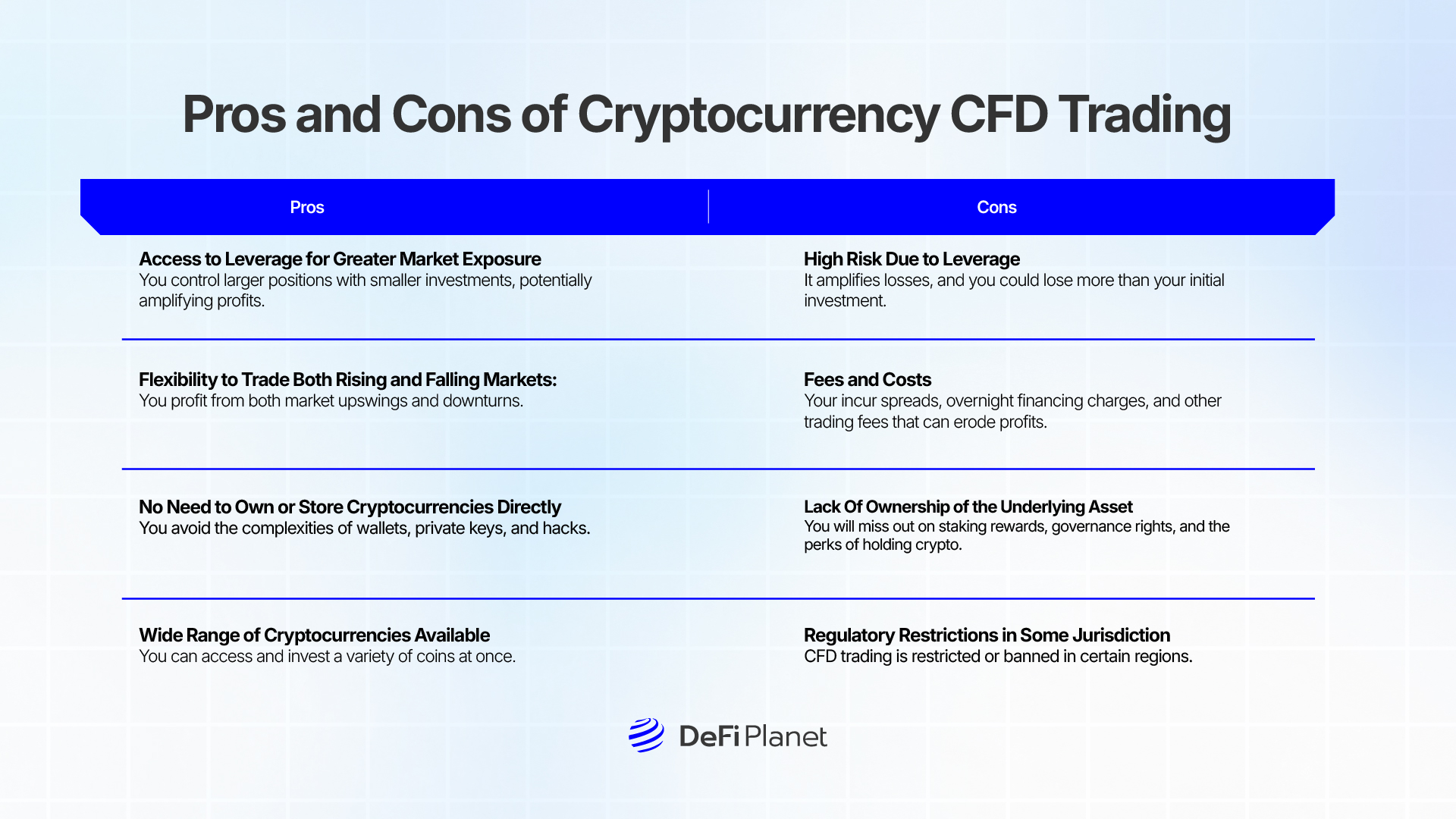When blockchain technology first emerged, trading virtual coins was relatively simple. Buyers and sellers either used dedicated cryptocurrency exchanges or negotiated deals directly through the OTC (over-the-counter) market. This straightforward approach suited the early days of crypto when it was a niche interest primarily among tech enthusiasts.
As cryptocurrency gained broader adoption, the market’s complexity grew, and so did the demand for more advanced trading tools. Traditional methods of buying and selling became insufficient for an asset class characterized by rapid price swings and speculative trading.
That’s where Contracts for Difference (CFDs) come in. CFD is a trading instrument used for assets like gold and oil. CFDs provided traders a way to profit from price movements without owning the underlying asset, making them an ideal fit for cryptocurrency trading.
Cryptocurrency CFD trading quickly gained popularity as it offered a streamlined way to trade on asset volatility. Unlike traditional crypto transactions, CFDs remove the need for wallets or deep blockchain knowledge, allowing traders to focus on market speculation. The simplicity of cryptocurrency CFD trading and the potential for significant returns have made it a favoured tool for seasoned investors and newcomers exploring the market.
This article will discuss cryptocurrency CFD trading, explaining how it works, including the risks and benefits. We’ll also provide practical advice on selecting a trustworthy broker to ensure a secure and successful trading journey.
How CFDs Work in Crypto Trading?
Cryptocurrency CFD trading is different from buying or selling actual cryptocurrencies like Bitcoin or Ethereum. CFDs mirror the price of the crypto. So, if you want to trade 100 ETH (Ethereum), you can buy 100 ETH CFDs. This allows you to use leverage (borrowed funds) and choose whether you think the price will go up (go “long”) or down (go “short”).
RELATED: Beginner’s Guide To Investing In Crypto
Leverage is a big deal in crypto CFD trading. It lets you trade more than you actually have in your account. For example, if you use 5x leverage, you can trade $5,000 worth of crypto with just $1,000.
But here’s the catch: leverage magnifies everything. If the trade goes your way, your profits will be bigger. But if it doesn’t, your losses will also be bigger, and you could lose your entire investment. That’s why managing risk is so important.
What Does It Mean to Go Long or Short?
When trading CFDs, you can choose to go long (betting the price will rise) or short (betting the price will fall).
Going Long
If you think the price will rise, you go long. You’re essentially “buying” the CFD now, hoping to “sell” it later for a higher price.
For example:
- Bitcoin is $60,000.
- You go long on 1 Bitcoin with a 20% margin (5x leverage), costing $12,000 upfront.
- If Bitcoin rises to $65,000, you profit $5,000 (minus fees).
- If Bitcoin drops to $55,000, you lose $5,000 (plus fees).
Going Short
If you think the price will fall, you go short. You’re “selling” the CFD now, planning to “buy” it back later at a lower price.
For example:
- Bitcoin is $60,000.
- You go short on 1 Bitcoin with a 10% margin (10x leverage), costing $6,000 upfront.
- If Bitcoin drops to $55,000, you profit $5,000 (minus fees).
- If Bitcoin rises to $65,000, you lose $5,000 (plus fees).
Crypto CFD trading gives you flexibility and the chance to profit in both rising and falling markets. But remember, leverage can work both for and against you. Always understand the risks before jumping in.
RELATED: How To Trade Crypto Responsibly
Pros of Cryptocurrency CFD Trading
Cryptocurrency CFD trading is an appealing choice for many traders because it offers several advantages. Here are some of those benefits:
Access to Leverage for Greater Market Exposure
One of the biggest perks of CFDs is leverage, which allows you to control a larger position with a smaller upfront investment. For instance, with 10x leverage, you can trade $100,000 worth of cryptocurrency with just $10,000. This can significantly amplify your potential profits, especially in a volatile market like crypto. However, it’s essential to use leverage responsibly, as it also increases the risk of losses.
Flexibility to Trade Both Rising and Falling Markets
With Crypto CFD trading, you’re not limited to profiting only when prices go up. Traders can open long positions (betting the price will rise) or short positions (betting the price will fall). This flexibility means you can potentially make money even during market downturns, which isn’t possible when directly owning cryptocurrencies.
No Need to Own or Store Cryptocurrencies Directly
When trading CFDs, you don’t own the actual cryptocurrency. This eliminates the hassle and risks associated with storing crypto, such as managing private keys, dealing with wallets, or worrying about hacks. It also removes the need to navigate blockchain technology, making CFD trading a more straightforward option for beginners.
Wide Range of Cryptocurrencies Available
Many brokers offering CFDs provide access to a broad selection of cryptocurrencies, from popular ones like Bitcoin and Ethereum to smaller altcoins. This variety allows traders to diversify and manage their portfolios to capitalize on opportunities across different assets without needing to own each cryptocurrency.
24/7 Availability on Mobile
One of the best things about crypto CFD trading is that you can trade anytime, anywhere, using your phone. The crypto market never closes, so you don’t have to worry about missing out on important price changes. Whether you’re at work, hanging out with friends, or just chilling at home, you can open the trading app on your phone and make moves in real time.

Cons of Cryptocurrency CFD Trading
While cryptocurrency CFDs offer exciting opportunities, they come with certain risks that traders should be aware of before diving in.
High Risk Due to Leverage
Leverage allows traders to control larger positions with a smaller amount of money, but it also increases the risk. If the market moves against you, the losses can be amplified, and you could lose more than your initial investment. For example, using leverage can make a small price change cause a big loss, so it’s important to use leverage carefully and only if you understand the risks involved.
Fees and Costs
CFD trading isn’t free. Brokers charge fees that can include spreads (the difference between the buy and sell price) as well as overnight financing charges for holding positions open overnight. These costs can add up over time, especially if you’re holding positions for a long time or making frequent trades. It’s important to be aware of these fees and how they might affect your overall profits.
Lack of Ownership of the Underlying Asset
When you trade cryptocurrency CFDs, you’re not actually owning the cryptocurrency itself. This means you don’t get the benefits that come with owning crypto, such as voting rights in governance decisions, staking rewards, or the ability to hold your assets in a personal wallet. CFDs are simply contracts based on price movements, so you’re missing out on certain advantages that come with owning the actual asset.
Regulatory Restrictions in Some Jurisdictions
CFD trading isn’t allowed in all countries or regions due to regulatory concerns. Some governments impose strict rules or bans on trading CFDs to protect consumers from high-risk investments. Before you start trading, it’s important to check the regulations in your country or jurisdiction to ensure you’re trading legally and in line with local laws.
How to Select the Right Broker for Cryptocurrency CFD Trading
Choosing the right broker for cryptocurrency CFD trading is crucial for ensuring a safe and profitable experience. Some well-known brokers offering crypto CFDs include eToro, which is popular for its user-friendly platform and strong regulatory compliance. Plus500 is another option known for offering a wide range of CFDs, including major cryptocurrencies like Bitcoin and Ethereum, along with competitive spreads.
For more experienced traders, IG Group is a reputable option that provides access to crypto CFDs, an advanced trading platform, and a wealth of educational resources to help traders make informed decisions.
With a variety of brokers available, it’s important to consider key factors that will influence both your success and security in the market.
- Security and Regulatory Compliance: Always choose a broker that adheres to local regulations and operates under licenses from trusted regulatory bodies. This helps ensure that your funds are secure and that the broker follows strict financial guidelines.
- Trading Fees, Spreads, and Commissions: Pay close attention to the trading fees associated with CFDs, including spreads (the difference between buy and sell prices) and any commissions the broker may charge. Compare these costs across different platforms to find one with competitive rates.
- Available Cryptocurrencies and Leverage Options: Brokers should offer a variety of cryptocurrencies for CFD trading, such as Bitcoin, Ethereum, and altcoins like Litecoin and Ripple. Leverage options (e.g., 2x, 5x, or more) can amplify potential profits but also increase risks, so make sure the leverage suits your risk tolerance.
- Trading Platform Usability and Tools: A good trading platform should be easy to use, with a clean interface, real-time market data, and charting tools. Look for brokers that offer demo accounts, advanced technical analysis tools, and mobile apps for trading on the go.
- Customer Support and Educational Resources: Strong customer support is critical, especially when issues arise during trading hours. Look for brokers that offer 24/7 support via multiple channels (live chat, email, phone). Educational resources, including guides, webinars, and tutorials, can also help you improve your trading skills and understand the market better.
Final Thoughts
Selecting a reliable broker and understanding the risks involved is paramount when engaging in cryptocurrency CFD trading, particularly in the volatile crypto world. CFDs offer great opportunities for speculation, but they also carry significant risks due to leverage and market fluctuations. It’s crucial to research thoroughly, choose a regulated broker, and ensure you have a clear strategy in place.
Responsible trading involves staying informed, managing risk, and never investing more than you can afford to lose. By being cautious and educated, you can navigate the complexities of crypto CFDs and make more informed decisions to enhance your trading experience.
Disclaimer: This article is intended solely for informational purposes and should not be considered trading or investment advice. Nothing herein should be construed as financial, legal, or tax advice. Trading or investing in cryptocurrencies carries a considerable risk of financial loss. Always conduct due diligence.
If you would like to read more articles like this, visit DeFi Planet and follow us on Twitter, LinkedIn, Facebook, Instagram, and CoinMarketCap Community.
Take control of your crypto portfolio with MARKETS PRO, DeFi Planet’s suite of analytics

